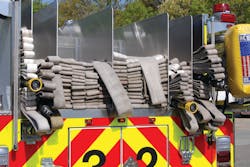The Apparatus Architect: Matching Your Apparatus to Your Needs
For some time, The Apparatus Architect articles have discussed the importance of defining the mission of the apparatus prior to the development of specifications and meetings with manufacturer’s representatives. Beyond the importance of justifying the financial expense for any new apparatus, a fire department must ensure that the final product when delivered and placed into service will meet the operational needs of the fire department and not just simply be the new pumper to replace the oldest unit in the fleet. This article will review several examples that highlight fire departments that focused on designing practical and efficient pieces of apparatus that would enhance the safety and support their operational needs.
At times, it is admittedly difficult to embrace all of the missions that a department must provide while focusing on the most important one of being able to effectively combat any type of structural fire. As many agencies provide a multitude of services including technical rescue, hazardous material mitigation and EMS responses, our basic mission is to provide fire protection and at least some of our apparatus must be designed to meet this need.
Meeting local needs
In Prince George’s County, MD, several departments have recently placed new apparatus into service to meet the needs of their response districts. In Fort Washington, Allentown Road Station 32, under the direction of Chief Nick Finamore, operates a short wheelbase Spartan/Crimson pumper with an overall length of 27 feet, six inches. Engine 823 was designed to operate in tight areas and is equipped with a 1,500-gpm pump and 500-gallon water tank. The rear hosebed is just 58 inches from the ground with four attack lines at 1¾, two and 2½ inches. The new apparatus enhanced Station 32’s engine company operations and proves that units do not have to be large in size to provide good service to the community.
The College Park Volunteer Fire Department operates as Station 12 in Prince George’s County and protects the University of Maryland campus with numerous high-rise buildings. Chief Bill Corrigan oversees the department’s fleet of two engines, a foam unit, a ladder truck and two ambulances that responded to 4,073 incidents in 2011. Engine 122 is a 2012 Pierce Arrow XT 2,000-gpm pumper that was designed by the department’s apparatus committee to meet the unique needs of its first-due area. The engine is built with a 174½-inch wheelbase with an L-shaped, 500-gallon water tank. The major attack lines come off the rear of the apparatus with a bumper mounted attack line and trash line provided at the left side pump panel. The high-rise packs are carried above the right-side body compartments, which allows personnel to safely deploy them without having to use steps or running boards. Additional safety items include a windshield down-view mirror, backup camera and reinforced stainless steel bumper.
Busy squad unit
For a number of years, Rescue Squad 27 from the Morningside Volunteer Fire Department has been one of the busiest squads in Prince George’s County, responding to more than 2,000 incidents each year. The station in the past had also operated with two engines that account for another 1,200-plus runs. With this in mind, the members set out to design a rescue engine that could operate as a backup to the rescue squad and provide engine company service when required.
Rescue Engine 27 was built by CustomFIRE Apparatus on a Spartan Gladiator chassis after many hours of specification development and work by Captain Mike Poetker with the station’s apparatus committee. The rescue engine was built on a 199-inch wheelbase, overall length of 33 feet and height of 116 inches. The stainless steel body has full-depth compartments on both sides with the ground ladders stored under the hosebed. Using an L-shaped, 500-gallon water tank, the hosebed is 66 inches from the ground with six pre-connected handlines in three different locations. The tool and equipment mounting was done by CustomFIRE to maximize the available space inside the cab and body.
The Reading, MA, Fire Department set out to replace its aging rear-mount ladder truck. After evaluating its responses, the department acquired a Seagrave Marauder II 100-foot rear-mount ladder equipped with a 500-gpm pump and 300-gallon water tank. The department, under the command of Chief Greg Burns, operates two engines, a ladder truck and a medic unit from two stations with on-duty personnel. The ladder truck was designed to be able to provide an initial-attack line at structure fires if the unit would be the first to arrive as well as for a protection line at vehicle accidents.
The Seagrave aerial ladder was built on a 225-inch wheelbase with a stainless steel cab and body. The pre-piped waterway is fed from the rear of the unit with smooth-bore tips attached to the ladder pipe. Captain Phil Boisvert and his group worked to develop specifications to replace both engines and the aerial ladder to provide standardized tool, equipment and hose loads on each apparatus.
Multi-function apparatus
The history of the Smithfield, VA, Volunteer Fire Department can be traced to 1939, when local residents discussed the need for community fire protection. Today, the department is guided by Chief Jason Stallings and operates three engines, a tower ladder, a rescue squad and a brush unit from Station 50 in Isle of Wight County. The department had outgrown its walk-in rescue truck on a commercial chassis and sought to replace this with a multi-function apparatus, as Smithfield protects a large portion of the county for technical rescue and rapid intervention team duties.
Rescue 50 was built by Seagrave with a 24-foot stainless steel body equipped with a 500-gpm pump, 300-gallon water tank, 30-kilowatt hydraulic generator, air cascade system and 83 feet of ground ladders. The upper-body compartments are accessed by a pull down ladder with full handrails. The steel-reinforced front bumper is equipped with a 15,000-pound-rated winch, trash line and rope tie-offs with a 9,000-pound portable winch provided for use at each side and rear of the body.
Combination rescue apparatus can be difficult to design as there are typically many more pieces of equipment that would be nice to have on the apparatus than there is available space to make things easy and safe to access without overloading the unit or making it so large that the squad is difficult to maneuver. The Smithfield Fire Department took many operational aspects into consideration before finalizing the design of its new rescue squad.
Smoothing the process
In today’s difficult financial climate, it is more important than ever to be able to specify apparatus that will meet the needs of the response area while enhancing the safety and operation of the vehicle. Designing apparatus that will serve the department and community into the future with a developed apparatus-replacement program will make the procurement process go along smoothly.
TOM SHAND, a Firehouse® contributing editor, is a 36-year veteran of the fire service and works with Michael Wilbur at Emergency Vehicle Response, consulting on a variety of fire apparatus and fire department master-planning issues. MICHAEL WILBUR, a Firehouse® contributing editor, is a lieutenant in the New York City Fire Department, assigned to Ladder Company 27 in the Bronx, and has served on the FDNY Apparatus Purchasing Committee. He consults on a variety of apparatus-related issues around the country. For further information, access his website at www.emergencyvehicleresponse.com.









